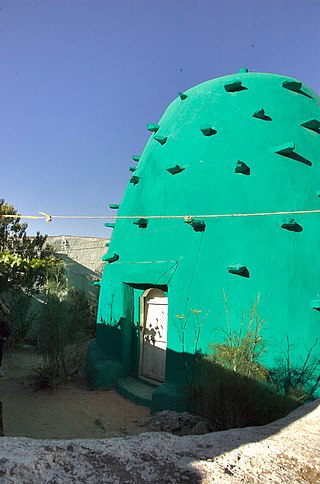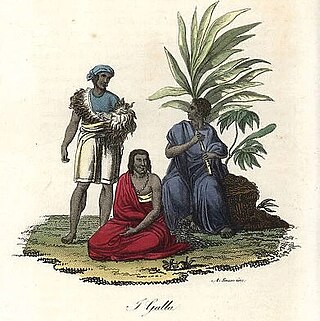
Harar, known historically by the indigenous as Harar-Gey or simply Gey, is a walled city in eastern Ethiopia. It is also known in Arabic as the City of Saints.

The Adal Sultanate, also known as the Adal Empire or Bar Saʿad dīn, was a medieval Sunni Muslim Empire which was located in the Horn of Africa. It was founded by Sabr ad-Din III on the Harar plateau in Adal after the fall of the Sultanate of Ifat. The kingdom flourished c. 1415 to 1577. At its height, the polity under Sultan Badlay controlled the territory stretching from Cape Guardafui in Somalia to the port city of Suakin in Sudan. The Adal Empire maintained a robust commercial and political relationship with the Ottoman Empire. Sultanate of Adal was alternatively known as the federation of Zeila.

Ahmad ibn Ibrahim al-Ghazi was the Imam of the Adal Sultanate from 1527 to 1543. Commonly named Ahmed Gragn in Amharic and Gurey in Somali, both meaning the left-handed, he led the invasion and conquest of Abyssinia from the Sultanate of Adal during the Ethiopian-Adal War. He is often referred to as the "King of Zeila" in medieval texts.

The Dir is one of the largest and most prominent Somali clans in the Horn of Africa. They are also considered to be the oldest Somali stock to have inhabited the region. Its members inhabit Djibouti, Somalia, Ethiopia, and northeastern Kenya.

The Gadabuursi, also known as Samaroon, is a northern Somali clan, a sub-division of the Dir clan family.

The Issa is a northern Somali clan, a sub-division of the Dir clan family.

Nur al-Din or Nur ibn Mujahidibn ‘Ali ibn ‘Abdullah al Dhuhi Suha was an Emir of Harar who ruled over the Adal Sultanate. He was known for marrying his uncle's widow, Bati del Wambara, and also succeeding Imam Ahmad as the leader of the Muslim forces fighting Christian Ethiopia. He is often known as the "King of Adel" in medieval texts.

The Ethiopian–Adal War, also known as the Abyssinian–Adal War and Futūḥ Al-Ḥabaša, was a war fought between the Christian Ethiopian Empire and the Muslim Adal Sultanate from 1529 to 1543. The Christian Ethiopian troops consisted of the Amhara, Tigrayans, Tigrinya and Agaw people, and at the closing of the war, supported by the Portuguese Empire with no less than four hundred musketeers. The Adal forces were composed of Harla, Somali, Afar, as well as Arab and Turkish gunmen. Ethnic Somalis constituting the largest contingent. Both sides would see the Maya mercenaries at times join their ranks.

The Karanle are a Somali clan, forming one of the six branches of the larger Hawiye clan. The Karanle are geographically spread out across three countries: Somalia, Ethiopia, and Kenya. Among all of the Karanle inhabited regions of the Horn of Africa, Ethiopia is the where the majority of the clan reside. In Ethiopia, the Karanle are mainly found in Harar, Hubat, and Babile but they also inhabit the Somali Region, Dire Dawa and surrounding regions. The majority of the Karanle Sub-clans predominantly reside in the regions of Ethiopia where the Somali population is predominant, with the exception of the Murusade Sub-clan, who reside in central and southern Somalia.

The Harari people are a Semitic-speaking ethnic group which inhabits the Horn of Africa. Members of this ethnic group traditionally reside in the walled city of Harar, simply called Gēy "the City" in Harari, situated in the Harari Region of eastern Ethiopia. They speak the Harari language, a member of the South Ethiopic grouping within the Semitic subfamily of the Afroasiatic languages.
The Harla, also known as Harala, Haralla are an ethnic group that once inhabited Ethiopia, Somalia, and Djibouti. They spoke the now-extinct Harla language, which belonged to either the Cushitic or Semitic branches of the Afroasiatic family.

The Oromo expansions or the Oromo invasions, were a series of expansions in the 16th and 17th centuries by the Oromo. Prior to their great expansion in the 16th century, the Oromo inhabited only the area of what is now modern-day southern Ethiopia and northern Kenya. Over the centuries due to many factors, mostly the wars between the Adal Sultanate and the Ethiopian Empire would further encourage the numerous Oromo tribes to expand towards central and eastern modern Ethiopia.

The Emirate of Harar was a Muslim kingdom founded in 1647 when the Harari people refused to accept Imām ʿUmardīn Ādan as their ruler and broke away from the Imamate of Aussa to form their own state under `Ali ibn Da`ud.
The Jaarso, Giarso or Jarso is northern Somali clan, a sub-division of the Dir clan family They largely live in Ethiopia, in the Oromo Region and the Somali Region, especially in and around the ancient cities of Chinaksen, Harar and Jigjiga
The Gurgura, Gorgorah or Gurgure is a northern Somali clan, a sub-division of the Dir clan family.

The Egyptian invasion of Harar, was part of a conflict in the Horn of Africa between the Emirate of Harar, Sultan of Aussa, and Oromo tribesmen, and the Khedivate of Egypt from 1874 to 1885. In 1874, the Egyptians invaded Eastern Ethiopia, namely Hararghe and parts of the Somali coast, and ruled it for 11 years.
Dakkar, also known as Dakar, or Deker, was a historical Muslim town located in present-day eastern Ethiopia. It served as the first capital of the Adal Sultanate after its founding in the early 15th century by Sabr ad-Din III.

The Geri Koombe is a sub-clan of Darod, a prominent Somali clan with the earliest records of Garadship. Gerikombe is one of the greatest tribes in Darod. Gerikombe kablalax darod ismacil jabarti. The Geri live in the Somali Region of Ethiopia between Tuli guled, Harar and Jigjiga, in Wardheer zone, in Bale, Bay, the Kismayo regions and in the Northern Frontier District of Kenya like Wajeer Garissa.
Ahmed Girri Bin Hussein was a Somali military commander and general that served the Adal Sultanate. He played a very prominent role in the campaigns of Ahmad ibn Ibrahim al-Ghazi by bringing one of the largest armies to aid the Imam in Jihad. Ahmed Girri hailed from the Yabarray clan. He was also the chieftain of Habr Maqdi which was a collective of Yabarray and Bartire. He was regarded one of the most capable generals during the Conquest of Abyssinia alongside Garad Matan.

The Habr Maqdi was a historical Somali confederation that composed of multiple clans such as the Bartire and Yabarre who are considered now a part of the Jidwaaq and come under the Absame Darod branch. The Habr Maqdi are well known for their conquests in Abyssinia as they had played a very prominent role in Ethiopian-Adal War. They are famous for bringing the largest army and were very loyal to Imam Ahmed. Richard Burton documented the Bartire branch of Habr Maqdi to have long been connected with the emirs of Harar. Both sub-clans of Habr Maqdi are mentioned explicitly in Futuh al-Habesh.












